Gei-geki Eyes: A dynamic stage for Tokyo theater’s future leaders
Organized by the Tokyo Metropolitan Art Space in Ikebukuro, a staunch supporter of the work of young emerging practitioners, Gei-geki Eyes is a theater program that takes the form of a contest among young companies who will lead the next generation of the theater world.
This is the third installment in a series of articles produced collaboratively by the Tokyo Culture Creation Project and Tokyo Art Beat. In this piece, TABlog’s guest writer Manami Maeda introduces two of the six young theater groups that made an impressive showing at the recent Gei-geki Eyes festival.
Soon after Hideki Noda assumed his new post as artistic director of the Tokyo Metropolitan Art Space (TMAS) last year, a huge poster of his likeness came to adorn one side of the entrance to the building – proof that perhaps no other artistic director in the history of the theater can match Noda for his sheer performativity and stylishness. Although I admire Noda’s work, I had mixed feelings about his new appointment – after all that money spent on that extravagant publicity poster, one could not help but wonder what exactly he would bring to the TMAS. Soon after taking the helm, however, Noda launched this year’s edition of Geki-gei Eyes, a festival whose uniformly stellar lineup cut straight to the chase by giving theater fans what they had always wanted. The festival was an utter joy, and my misgivings, as it turns out, were completely unfounded.
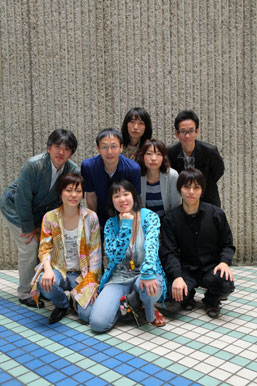
Gei-geki Eyes 2010 Line-Up Part 1 (finished)
http://www.geigeki.jp/saiji/007/
Suspendeds “2010 Oku Kounen”
Date: 2010.5.22 (SAT) – 30 (SUN)
Impara Praparat × Ebibimo pro.
“Ebi Para Bimo Parat”
Date: 2010.6.3 (THU) – 6 (SUN)
faifai “SHIBAHAMA”
Date: 2010.6.3 (THU) – 13 (SUN)
FUKAIPRODUCE hagoromo “AIJINI”
Date: 2010.6.12 (SAT) – 22 (TUE)
Gekidan-Shika 564 ”Densha Ha Ti De Hashiru”
Date: 2010.6.18 (FRI)- 7.4 (SUN)
gekidan, emoto junko “FUJINKOURON”
Date: 2010.7.15 (THU) – 25 (SUN)
Gei-geki Eyes 2010 Line-Up Part 2
Kaki-Kuu-Kyaku “Yukaihan”
Date: 2011.1.7 (FRI) – 16 (SUN)
Hyottoko Rambu “Roku Na Shinikata”
Date: 2011.2.3 (THU) – 13 (SUN)
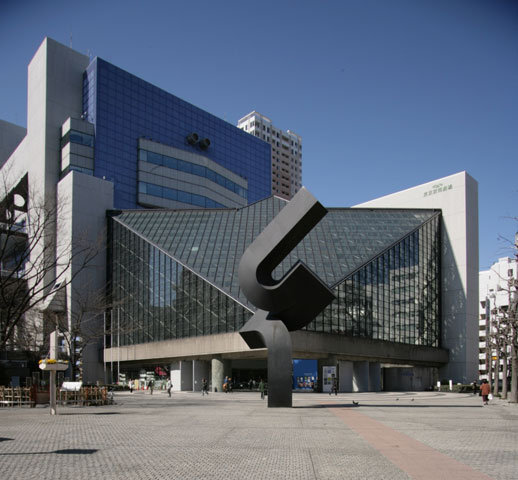
The second season, which ran from May through July this year, featured Suspendeds, a tightly-scripted collective whose performances are infused with a quiet honesty. Also included were collaborative performances by Impara Praparat × Ebibimo pro., a much talked-about outfit comprising two popular young theater groups who joined forces. faifai is a company that exudes a deliriously happy, upbeat aura, and FUKAIPRODUCE hagoromo stages bizarre, wacky musicals that combine eroticism with a sinister undertone. Gekidan-Shika 564 produces musical theater pieces charged with a performative power honed on the streets. On the other hand, gekidan, emoto junko is a new troupe that breaks new ground for dialogue-based theater led by the director of Kegawazoku, a more established theater group that Emoto founded in 2000.
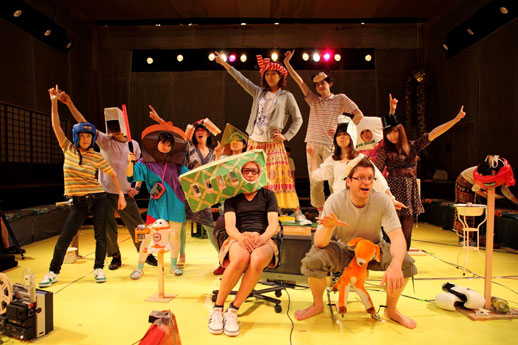
faifai’s youthful crew has an average age hovering around 28. It presented a bittersweet, absurd portrayal of the misadventures of a bunch of happy, lovable good-for-nothings entitled “SHIBAHAMA”, based on the classical rakugo comic storytelling work of the same name. Slacker hero Kuma-chan, who one day chances upon a huge wad of cash that would enable him to take it easy for the rest of his life, blows the money on a string of booze-fueled nights out on the town. Worried about her husband’s debauchery, however, Kuma-chan’s wife tries to convince him that his lucky windfall was just a dream in an effort to turn his behavior around, revealing to him that she had lied all along only some time later. This winning human drama ends with the self-reformed Kuma-chan a changed man, and all the better for having pocketed this extra bit of good fortune.
At first glance, the stage seemed to resemble a motley assortment of junk, made up of an astonishing array of props including various toys and everyday items that moved about and gave off weird noises. A palpable feeling of excitement began to rise from out of this cute, high-tech accumulation of miscellaneous objects like trails of steam, the toys and objects wriggling and squirming like a mound of garbage in some incredible dream.
The ensuing performance seemed to consist of fragments from some pleasure-seeking hedonistic dream inspired by the original “Shibahama” –- revelry and merrymaking at the races and in pubs and bars, painting the entire town red. Even the audience members were invited to lose themselves in the light-headed gambling mood: “rock, paper, scissors” tournaments were held during the performance, and the lucky winners got to be Kuma-chan for a day by enjoying special treatment and perks.
Apparently, a different special guest was invited each day of the performance, along with an entire program of amusements – contests to kill 100 people with a sword, for example, or serious boxing brawls. On the day I attended, the special guest was an underground “idol” singer from Akihabara, appearing with a contingent of loyal otaku fans who treated the audience to a pitch-perfect “wotagei” dance and cheering routine. The energetic “cheerleaders” enthralled everyone with their kickass performance, dispelling all of the audience’s negative otaku associations in one clean sweep – a truly inspiring moment that reaffirmed their hopes for the future.
Segueing from party to performance, “SHIBAHAMA” made the most of its carnival-like atmosphere and gave off a positive vibe throughout, but also left its audience with a faintly uncanny sensation. The hedonistic desire to kick back and have a good time was left hanging in midair: the short-lived revelry and merrymaking overlapped with the “dream” element that promised to disappear but did not, resulting in a subtle, fleeting sense of sorrow. Noticeably missing was the hopeful prospect of redemption built into the original “Shibahama” story.
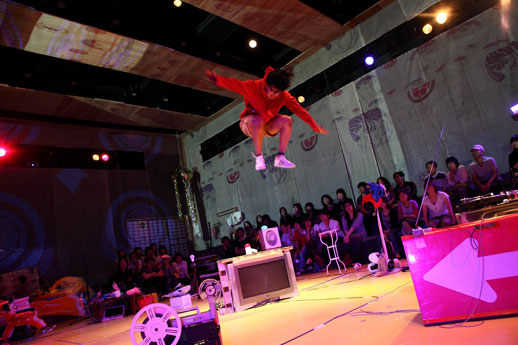 Shibahama’s Kuma-chan has it good – even though he thinks his sudden windfall is only a dream, his hopes of getting rich quick are fulfilled in the end. And even though they get to enjoy all those little moments of horsing around, however, the faifai gang don’t have any real money. But maybe that’s just fine by them. All that anxiety about the future of today’s youngsters – well, that’s really just the adults getting worked up about how these kids need to settle down and lead more stable lives.
Shibahama’s Kuma-chan has it good – even though he thinks his sudden windfall is only a dream, his hopes of getting rich quick are fulfilled in the end. And even though they get to enjoy all those little moments of horsing around, however, the faifai gang don’t have any real money. But maybe that’s just fine by them. All that anxiety about the future of today’s youngsters – well, that’s really just the adults getting worked up about how these kids need to settle down and lead more stable lives.
In this sense, faifai’s “SHIBAHAMA” is a denial of the values espoused by the adults who believe that today’s youngsters are pitiful because they’re poor. They have no money, but the faifai crew are probably happy just the way they are, even though they’re also still caught up in their dream. As the curtain begins to fall, the sight of the entire cast earnestly acting out the Shibahama storytelling routine hints at the sort of happy, contented lives that await them, as well as provoking us into thinking about the wistfulness of our own present situation.
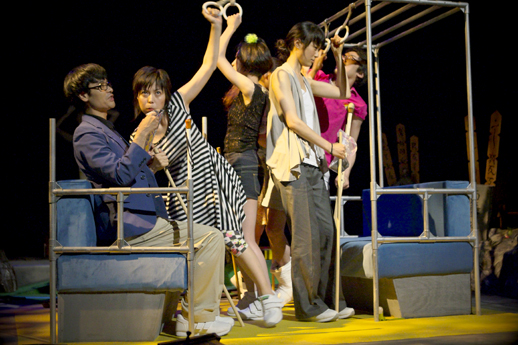
gekidan, emoto junko (Theater Emoto Junko) is a parallel project to Emoto’s Kegawazoku theater company, for which she has written dramatic, violent musical pieces that are by turns erotic and grotesque, inhabited by brutal characters and shot through with a sense of spurious glamor. Last year, she expanded the scope of her practice by organizing an ongoing, three-month-long series of performances that featured one new work per month, one of which finally made it to the shortlist for the Kishida Drama Award. Although I personally felt something of the labor and effort that had gone into creating the preposterous plotlines of Kegawazoku’s plays, I had not expected Emoto to make last year’s shortlist – a happy misjudgment on my part, nonetheless. The work she presented at this year’s Gei-geki Eyes, entitled “FUJINKOURON (Women’s Dispute)”, is her lavish and much-anticipated fourth production with this company, featuring a stellar lineup of actors.
The premise: a tour of the pitch-black theater given by a blind guide, which begins in total darkness. All of a sudden, the lights come on to reveal an installation spreading across the entire stage that appears to be a compressed version of a decrepit theme park. As it turns out, one of the participants on the tour had flipped the switch by mistake. A real variety of characters have turned up for the tour – someone who joined because a discount was available for groups of office colleagues, a guy who came along with his girlfriend, someone with a pseudo-intellectual interest in the whole affair, and a somewhat clueless individual who came expecting to witness something of a minor epiphany. All of them, however, are typical of Emoto’s host of characters, who tend to be difficult, troublemaking types.
A quarrel erupts during the tour just as the participants are trying to decide on nicknames. The blind guide seems not to have noticed that the lights have been turned on, so the four participants flip the switch back off and carry on with the tour. Perhaps there’s something magic about the darkness, though, because as soon as the lights go off everyone’s true feelings rise to the surface and the real, unvarnished truth about the relationships between them come out into the open.
While the women wage out this fierce bout of psychological warfare, the dedicated guide starts behaving like a bit of a pervert – licking their wounds while claiming that he’s helping to sterilize them, putting sanitary napkins on them instead of Band-Aids, grabbing their ass each time he stubbornly tries to tend to their injuries, and offering himself to one of the girls as a toilet seat. At first, his advances are more subtle, but his behavior soon crosses over into full-fledged molestation. Although clearly disturbed, these tough women make no forceful attempt to rebuff their blind companion. Before long, after the women have been forced to endure a whole series of manhandlings, the tour comes to a close…at which point the blind guide writes out a message to the participants: “Please refrain from turning the lights on and off while the tour is in progress”. The curtain falls as the women gape in astonishment.
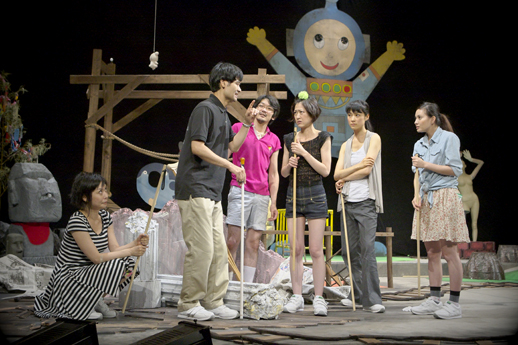 Plunged into darkness, the blind man has the upper hand. The women, however (who like most of us somehow assume that all disabled people are well-intentioned), get the shock of their lives when their guide turns out to be nothing more than a common thug in the dark. If even the weak have bad intentions, there are reasons behind their desires. Looking squarely on as this blind tyrant openly commits all manner of atrocities, these women pardon him on the grounds of some unseen weakness even as they maintain their utmost composure. The guide, for his part, pretends not to have noticed that the lights had come on halfway through the tour. Feigning innocence as the tour carries on, he remains fully aware that a considerable degree of mischief by the “weak” is being condoned.
Plunged into darkness, the blind man has the upper hand. The women, however (who like most of us somehow assume that all disabled people are well-intentioned), get the shock of their lives when their guide turns out to be nothing more than a common thug in the dark. If even the weak have bad intentions, there are reasons behind their desires. Looking squarely on as this blind tyrant openly commits all manner of atrocities, these women pardon him on the grounds of some unseen weakness even as they maintain their utmost composure. The guide, for his part, pretends not to have noticed that the lights had come on halfway through the tour. Feigning innocence as the tour carries on, he remains fully aware that a considerable degree of mischief by the “weak” is being condoned.
Judging from the title of the performance, I somehow assumed that the blunt, point-blank chatter of the women would end in a riot of explosive emotion. What I actually got to see, however, were the strategies devised by the weak, expressed in the form of the blind guide’s behavior. It was in fact somewhat satisfying to see these women, who typically adopt a nonchalant attitude to what transpires around them, falter and lose their cool as the guide’s antics throw them off balance. Nonetheless, these four characters, each of whom is bothersome in their own way, were skillfully portrayed. I was also particularly impressed with the way in which Emoto boldly exposed the secret erotic desires of a handicapped person.
Apparently, the spring 2011 edition of Gei-geki Eyes is still in the midst of being planned due to scheduled renovation work to the theater – the festival may potentially continue, but in a different form. Personally, I would be delighted if further improvements could be made to the seating (which could do with a better view) and usability of the stage, so that the festival can return home to TMAS, with its performers much better served by its improved layout and facilities. Hopefully, Gei-geki Eyes will tighten up its act even more and present a new, exciting lineup that we can count on Noda to deliver.
Guest writer: Manami Maeda
Received an MA from the Department of Theater Studies at Lancaster University. After a stint as an assistant at the Tsubouchi Memorial Theater Museum at Waseda University, she now occasionally works as a dance and theater writer, contributing magazine and web articles about contemporary dance and fringe theater productions.
Tokyo Culture Creation Project
Tokyo Culture Creation Project


